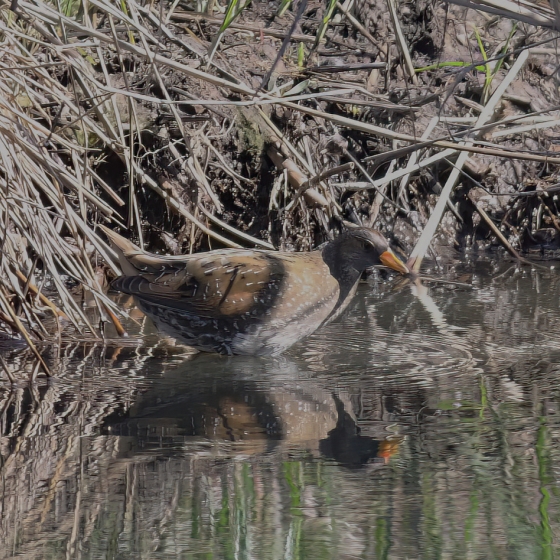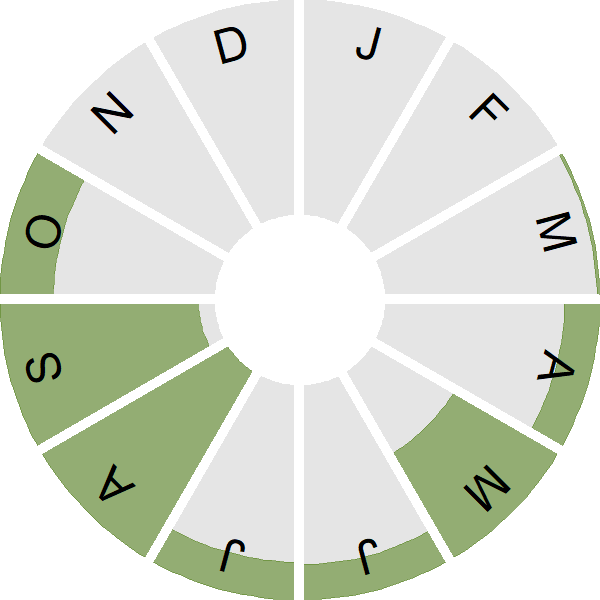Spotted Crake

Introduction
The Starling-sized Spotted Crake is a rare and elusive bird of fen and marsh that is more often heard than seen.
Spotted Crakes winter in Africa and are summer visitors to the UK, arriving in April. The UK breeding population is thought to number fewer than 30 calling males, but the species is very difficult to census. The biggest challenge is that we have very little knowledge of how calling relates to breeding activity and abundance. The calling period can extend from early April to the end of August, varies in its timing between nights, and males appear to fall silent once paired.
In most years a few Spotted Crakes can be heard across the UK but the breeding population has always been a shifting one.

Key Stats
Identification
Songs and Calls
Song:
Status and Trends
Conservation Status
Population Change
The Spotted Crake was probably much more common up to the late nineteenth century but suffered a major decline and it has subsequently remained scarce as a UK breeding species (Stroud et al. 2012). It has declined since the 1999 survey when around 80 males were present (Gilbert 2002, Stroud et al. 2012), with the most recent national survey finding a population of 28 singing males (Schmitt et al. 2015). A five-year mean of 20 breeding pairs reported to the RBBP over the period 2015–2019 (Eaton et al. 2021) although RBBP figures are usually incomplete for this species (Stroud et al. 2012).
Distribution
Spotted Crakes are very rare, but regular, breeding migrants. During 2008–11 breeding was confirmed in southwest England and Yorkshire and probable breeding was reported from Somerset, East Anglia, Yorkshire, the Inner and Outer Hebrides and the Northern Isles.
Occupied 10-km squares in UK
or view it on Bird Atlas Mapstore.
or view it on Bird Atlas Mapstore.
European Distribution Map
Distribution Change
The Spotted Crake population has declined since the early 2000s, in terms of both breeding birds and passage migrants .
Change in occupied 10-km squares in the UK
or view it on Bird Atlas Mapstore.
or view it on Bird Atlas Mapstore.
Seasonality
Spotted Crakes are scarce summer visitors and autumn migrants.
Weekly pattern of occurrence
The graph shows when the species is present in the UK, with taller bars indicating a higher likelihood of encountering the species in appropriate regions and habitats.

Movement
Britain & Ireland movement
Foreign locations of birds ringed or recovered in Britain & Ireland
Dots show the foreign destinations of birds ringed in Britain & Ireland, and the origins of birds ringed overseas that were subsequently recaptured, resighted or found dead in Britain & Ireland. Dot colours indicate the time of year that the species was present at the location.
- Winter (Nov-Feb)
- Spring (Mar-Apr)
- Summer (May-Jul)
- Autumn (Aug-Oct)

European movements
EuroBirdPortal uses birdwatcher's records, such as those logged in BirdTrack to map the flows of birds as they arrive and depart Europe. See maps for this species here.
The Eurasian-African Migration Atlas shows movements of individual birds ringed or recovered in Europe. See maps for this species here.
Biology
Productivity and Nesting
Nesting timing
Egg measurements
Clutch Size
Survival and Longevity
Survival is shown as the proportion of birds surviving from one year to the next and is derived from bird ringing data. It can also be used to estimate how long birds typically live.
View number ringed each year in the Online Ringing Report.
lifespan
Biometrics
Wing length and body weights are from live birds (source).
Ring Size
Classification, names and codes
Classification and Codes
- Order: Gruiformes
- Family: Rallidae
- Scientific name: Porzana porzana
- Authority: Linnaeus, 1766
- BTO 2-letter code: AK
- BTO 5-letter code: SPOCR
- Euring code number: 4080
Alternate species names
- Catalan: polla pintada europea
- Czech: chrástal kropenatý
- Danish: Plettet Rørvagtel
- Dutch: Porseleinhoen
- Estonian: täpikhuik
- Finnish: luhtahuitti
- French: Marouette ponctuée
- Gaelic: Traon-breac
- German: Tüpfelsumpfhuhn
- Hungarian: pettyes vízicsibe
- Icelandic: Dílarella
- Irish: Gearr Breac
- Italian: Voltolino
- Latvian: ormanitis, tutinš
- Lithuanian: paprastoji švygžda
- Norwegian: Myrrikse
- Polish: kropiatka
- Portuguese: franga-d'água-malhada
- Slovak: chriašt bodkovaný
- Slovenian: grahasta tukalica
- Spanish: Polluela pintoja
- Swedish: småfläckig sumphöna
- Welsh: Rhegen Fraith
Research
Causes of Change and Solutions
Causes of change
Causes of change are difficult to assess and long-term trends are unclear due to the difficulty in monitoring this cryptic breeding species. Spotted Crakes prefer wetter conditions away from scrub and lack of management and vegetation succession is a possible cause of some local declines (Stroud et al. 2012).

